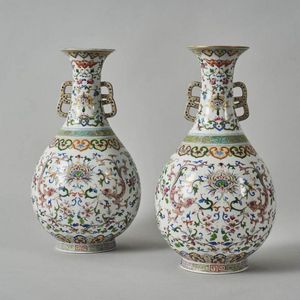Famille Rose Chi-Dragon Vases with Handles
A pair of Chinese mid Qing Dynasty famille rose chi-dragon vases with handles, the pear-shaped body rising from a splayed foot to a waisted cylindrical neck with a galleried rim, flanked by a pair of gilt-decorated archaistic handles, the body brightly depicting stylised lotus blooms borne on meandering leafy scrolls, all divided by ruyi head and keyfret bands, encircled at the rim and the foot with bands of foliate motifs, iron red a six-character Qianlong seal mark to the base, height 32 cm, diameter 16.5 cm
You must be a subscriber, and be logged in to view price and dealer details.
Subscribe Now to view actual auction price for this item
When you subscribe, you have the option of setting the currency in which to display prices to $Au, $US, $NZ or Stg.
This item has been sold, and the description, image and price are for reference purposes only.
- Foliate - Decorated with leaves or leaf-like forms.
- Ming Dynasty - The Ming Dynasty was a ruling dynasty of China from 1368 to 1644. It succeeded the Yuan Dynasty and preceded the Qing Dynasty. The Ming Dynasty was established by Zhu Yuanzhang, a former Buddhist monk who became a rebel leader and eventually overthrew the Mongol Yuan Dynasty. During the Ming Dynasty, China experienced a period of relative stability and prosperity. The government was centralized and bureaucratic, with the emperor at the top of the hierarchy. The Ming Dynasty is known for its cultural achievements, including the development of porcelain, the invention of movable type printing, and the construction of the Great Wall of China.
- Qing Dynasty - The Qing Dynasty was the last imperial dynasty of China, ruling from 1644 to 1912. It was established by the Manchu people, who originated from the northeastern region of China. The Qing Dynasty was preceded by the Ming Dynasty and followed by the Republic of China.
This item has been included into following indexes:
